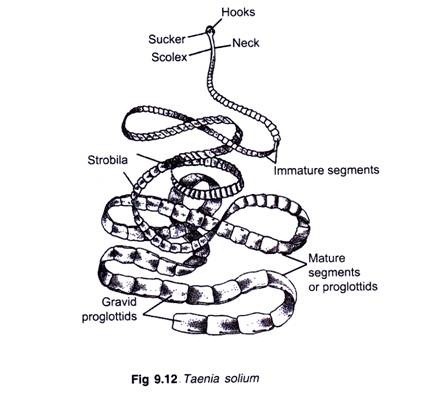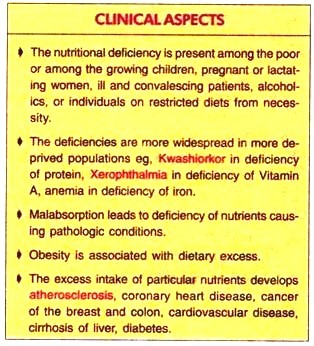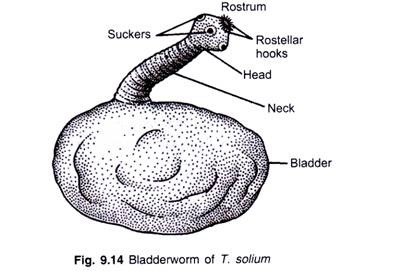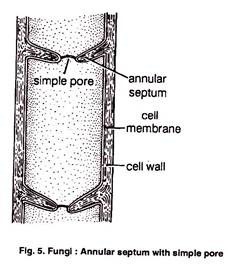Read this article to learn learn about the Structure and Life Cycle of Taenia !
Systemic Position
Phylum: Platyhelminthes
Class: Eucestoda
Order: Taenioidea
Genus: Taenia
Species: solium
Taenia is a digenetic parasite. Man is the primary or definitive host, the secondary host for T.solium is pig. The body is elongated, dorso-ventrally flattened and ribbon-like. It is also called tapeworm as the shape of the body is like a tape. The size of adult worm varies from 3-5 metres i.e., 9-16 feet, but few are recorded to attain a length of about 8 metres. The body is opaque white but may be grey, yellow or creamy. The body of Taenia is modified for parasitic mode of life.
It is distinguished into three parts:
1. Head and scolex
2. Neck
3. Body or strobila.
1. Head or scolex:
The scolex is the anterior- most knob like part of the size of pin head. It is a four- sided, pear-shaped structure distinguished into two parts-
(i) Rostellar part:
Rostellum is the proximal conical part bearing at its base two rows of curved and pointed chitinous hooks. These are about 28 in number and of two different sizes and the smaller hoods alternate with the larger ones. The rostellum is slightly retractile.
(ii) Distal four-sided part:
It lies posterior to the rostellum and possesses four cup-shaped suckers. One of them is dorsal, one ventral and two are lateral.
2. Neck:
The scolex is followed by a narrow un-segmented neck region. New segments are budded off from this region by budding. Hence it is also known as the region of proliferation or area of segmentation (fig. 9.12).
3. Strobila:
The rest of the body is known as strobila. It is composed of linear series of 800 to 1,000 sets of reproductive organs or genitalia, each set being contained in a segment. This linear repetition of genital organs is termed as proglottisation and each segment is known as proglottid. Since the segments are budded off from the neck region in an orderly succession, the youngest segments are towards the neck and the oldest segments are posterior most.
Reproductive System:
The reproductive organs are segmentally repeated and each segment carries a complete set of male and female reproductive organs (i.e., hermaphrodite).
A. Male Reproductive Organs:
The male reproductive organs are:
1. Testes
2. Vasa efferentia
3. Vas deferens
4. Cirrus and cirrus sac
1. Testes:
The testes are numerous minute round bodies scattered throughout the dorsal part of the proglottid. The number of testes varies from 15 to 200.
2. Vasa efferentia:
These are numerous minute ducts which arise from testes and collectively open into the vas deferens.
3. Vas deferens:
It is a long coiled tube which arises from the middle of the segment and runs transversely either to the left or right to open into the genital atrium.
4. Cirrus and cirrus sac:
The distal end of vas deferens is modified into a protrusible cirrus which is surrounded by a muscular pouch, the cirrus sac. The cirrus is beset with spines, bristles, or hooks and opens into the genital atrium through male genital pore.
B. Female Reproductive Organs:
1. Ovaries
2. Oviducts
3. Ootype
4. Vagina
5. Uterus
6. Vitelline gland
7. Mehlis glands.
1. Ovaries:
There are two ovaries situated in the medulla towards the posterior end. These are dorsoventrally flattened, highly branched and connected together by a transverse bridge.
2. Oviduct:
The oviduct arises from the middle of the bridge. It is a short and wide duct and opens into the ootype.
3. Ootype:
It is a small rounded chamber developed at the junction of oviduct with the vitelline duct. It is surrounded by numerous unicellular shell glands or Mehlis glands.
4. Uterus:
A blind sac-like or tube -like uterus arises from the ootype and runs forward in the segment. In gravid proglottids the uterus enlarges and gets branched to occupy the whole of the proglottid. It remains filled with the fertilized ova or developing embryos.
5. Vagina:
It is the narrow tubular part. It opens into the genital chamber by female reproductive opening. The seminal receptacle is a small wide tube connected on one hand with the ootype by a narrow spermatic duct and on the other with vagina.
6. Vitelline gland:
The vitelline gland is a compact, elliptical mass of numerous follicles situated posterior to the ovaries. The secretion of the vitelline duct is rich in yolk and forms a covering to yolk around the fertilized egg.
7. Shell gland or Mehlis glands:
These are numerous minute unicellular glands situated at the ootype.
Life- History:
The life-history is complicated and digenetic, being completed in two hosts. The primary host is man and the secondary host is pig.
1. Fertilization:
Self-fertilization takes place in Taenia. The cirrus of the segment is inserted into the vagina of the same segment. The sperms received are stored in the seminal receptacle. The eggs are fertilized in the oviduct and get surrounded with yolk and egg-shell in the ootype. The capsulated egg enters the uterus and is collected there. The uterus enlarges in size, gets branched and occupies the whole space. The eggs are very small in size measuring about 40 microns in diameter. These contain a large amount of yolk and each is surrounded by an egg-shell or egg-capsule.
2. Cleavage:
The division in the eggs start, while these are- still inside the uterus. The first cleavage is unequal so that a large vitelline cell and a small embryonic cell is formed. The embryonic cell undergone repeated divisions and a solid ball of cells, the morula is formed. The divisions are unequal so the morula consists of a few larger cells, the macromeres forming an outer or peripheral layer and inner mass of small cells or micromeres.
3. Hexacanth larva:
The micromeres develop into a hexacanth or onchosphere larva.
4. Infection to secondary host:
The development of egg up to the formation of onchosphere takes place inside the uterus of gravid proglottid. The further development is not possible inside the host body. The gravid proglottids detach from the body of the parasite and come out along with the host faeces. These infect the secondary host when pig feeds upon the contaminated faeces.
5. Cysticerus or hydatid larva or bladderworm stage:
The numerous hexacanths are set free in the stomach, where the embryonic membranes of onchospheres is dissolved (fig. 9.14) These bore through the intestinal wall the help of hooks and enter the blood stream or lymph vessels. Travelling through the heart, these enter the muscles of various parts in the body. The usual site where the hexacanths gey encysted is the voluntary muscles of tongue, heart, liver and shoulder.
6. Infection of final host:
Further development of the bladder worm takes place only inside the definitive host. Infection of man occurs when inadequately cooked pork infected with bladderworms is eaten. The cysticerci become active in the intestine. The scolex takes a firm hold of intestinal wall of the host. The bladder is thrown off and the neck starts budding off segments an adult tapeworm is formed (fig. 9.15).
Infection of tapeworm can be prevented with high level of personal hygiene. The prevention of fecal contamination of pig foods may be helpful in prevention of contamination of these parasites.



